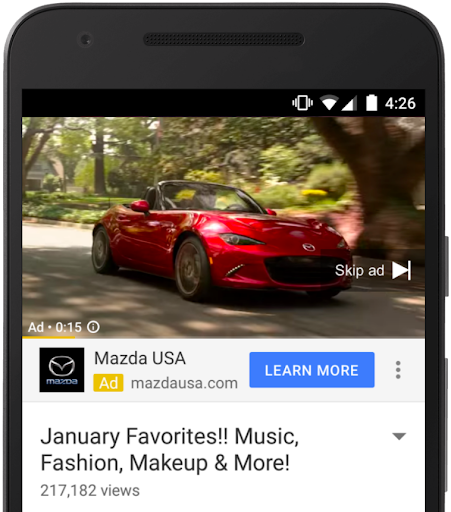Introduction
When designing an awareness media plan, and by extension any media plan at all, it is quite easy to get lost in all the different options that are available on the market. Choices need to be made regarding which platforms to advertise on, the type of the ad to go for, the format of the ad, and much more. The scope of this article will focus on two types of video ads on the Google platform, namely Bumper and Trueview In-Stream videos. The aim of this article is to better understand what these formats are, and which of these formats is best suited for an effective awareness campaign.
Awareness
Awareness can be summed up by the following sentence: it is the idea of getting your brand out there, making sure people know who you are as a brand, what you stand for and what your main scope is. Awareness campaigns are really focused on generating visibility, and not yet on pushing people towards a specific action. They mostly take the form of videos or banners, as these are efficient ways to quickly implement your seed in a user’s brain.
Awareness is the first, widest phase of the acquisition funnel (cfr. Image below). The funnel is shaped the way it is because the closer we get to the end of the acquisition process, the narrower the audience becomes. Indeed, there are far more people that know about the brand Mercedes-Benz, than people buying a Mercedes car for example. There are also probably more people wanting to buy a Mercedes car than people that actually proceed to buying it. The phase after the awareness phase is called consideration. Here, the aimed audience will already know the brand, and is still considering if it would be worthy or not to do a purchase (or any other relevant action, based on the business) from the brand in question. In this phase, an advertiser can already give more details on its offerings, rather than on the pure brand image and recognition. The last phase, namely conversion, is where an advertiser will really try to induce an action from an user. It might be filling in a form, subscribing to the newsletter, or adding a product to a cart. An user in the conversion phase already knows what the brand has to offer, and is mostly looking to make the move.

Bumper videos
Google describes bumpers ads as being a “short video ad format designed to allow you to reach more customers and increase awareness about your brand by using a short, memorable message.” These Youtube-hosted videos must last 6 seconds or less and allow advertisers to deliver their message while not requiring a long attention span from users. For this type of ads, bids are set based on target CPM, so it allows some form of control on the amount that ends up being spent. Bumper ads are effective on all devices, but even more on mobile because of the nature of their short format.
On the other hand, a disadvantage of bumper videos is that it is not possible to create remarketing lists out of views on bumper ads. Indeed, a view on a bumper ad will not be added to the view count, and is considered as an impression.

Trueview in-stream videos
The first main difference as compared to bumper ads is the bid strategy that is based on pay-per-view. This means that an advertiser pays per actual view of the video, instead of paying per impression. To shed more light on this, the advertiser basically pays once a user watches at least 30 seconds of the video, or the whole video if the length is inferior to 30 seconds. The advertiser also pays whenever the user engages with the video (through clicking on the website link or any CTA on the video). This leads us directly to the second main difference between bumpers: the video length. Trueview videos are videos of a longer format as opposed to the 6 seconds max of Bumpers. They allow to tell a longer, more complex message, and can include some sense of storytelling. The downside is that users can skip the video after 5 seconds, so the chances are much higher that they end up not watching the entire video, and thus do not get the whole message one wants to transmit. This being said, if the video lasts 15 seconds or less, the advertiser has the option to make the ad unskippable.

What to chose
Now that we have a clearer understanding on what bumpers and trueview videos are, as well as what awareness is about, we should be able to decide which video types suit best the first phase of the acquisition funnel.
In order to answer this question properly, we will look at two different points of views on the subject: by definition and by experiment.
By definition
If we take a look back to what bumpers ads are according to Google, part of the answer can actually be found in it. Indeed, Google states : “short video ad format designed to (...) increase awareness about your brand by using a short, memorable message”. So bumpers are definitely meant to be used for building awareness. The shortness of its format does not allow for an advertiser to give sufficient information in order for a user to consider evolving to the purchase process. It should really be used in order to give users some fast insights about who you are as a brand. Although useful for awareness, it is also known that bumpers work best while combined with other youtube videos, as merely 6 seconds can be quite challenging to generate a powerful impact on users.
Regarding Trueview videos, it is also stated that they should definitely be used in order to promote video content alongside other videos on Youtube, or their partner sites and apps. Running trueview alone would not be very effective, especially the skippable version of it, as it could mean that lots of users don’t see your whole message. Trueview videos allow for longer messages, so they have more relevance than bumpers to be used in the consideration phase for example.
By experiment
For one of our clients here at Semetis, we were also challenging which of the two formats was the most relevant for our Awareness campaigns. For this reason, we had both campaign types running alongside each other. After 6 weeks, we compared the results of both campaign types.

If we base ourselves solely on the above-mentioned metrics, then the conclusion is very clear: Bumpers work better for awareness. Not only do we have cheaper CPMs, we also have much cheaper CPVs and CPCs. The CTR also shows us that people tended to click on the ad more often via Bumpers than Trueview. It is basically cheaper to reach people and acquire visibility through running bumper ads than trueview ads. But it is important to understand that these video types are not in competition, and that an advertiser should take advantage of their complementarity.
Conclusion
The first option, which actually seems quite logical, is to run both types of ads alongside each other in order to generate awareness. We could for example retarget users that saw our Trueview ad with our bumper ads. In that way, we ensure people saw our entire message (if the ad is unskippable) or at least got the opportunity to get to know more about our brand (if the ad is skippable). We then follow-up by showing these same users the bumper ads. Indeed, the six second format would kind of lose its disadvantage of not allowing to transmit a lot of information - as these people could recall the trueview, full message ad they saw earlier. Bumpers could then be used to gently remind people about who we are, and maybe even add to the storytelling of the trueview ad.
Even without using it in a retargeting mindset, it is always inters ting to have the two formats running side-by-side in our awareness layer. As previously mentioned, they are not in competition, but complement each other in order to raise awareness about the brand.
The second option would be to run bumper ads in an awareness layer, and run the trueview in the consideration phase. Of course, as explained in the beginning of this article, it is of utmost importance to adapt the message of the video based on the phase of the acquisition funnel. The trueview should therefore be different from the content of the bumper ads, and give already more details on the business’ offerings rather than on pure branding. As a reminder, it is impossible to retarget people that saw the bumper ads with our trueview video, as bumper video views are considered as being impressions.
No matter which options an advertiser would go for, it is not recommended to merely run either only bumper videos or only trueview videos. They are really complementary to each other and their synergy is much bigger than the sum of the performances each video type would reach alone. The strength of the message is much bigger when both type of ads are combined. At first glance, it may sound bizarre to keep investing in trueview videos if bumper videos show better metrics, but the longer length of the trueview videos is at the basis of its more expensive nature. You pay more, but your brand is exposed to users for a longer period, and you can deliver a much longer message.



